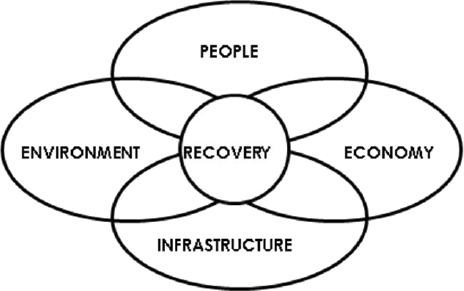Assessing the impacts of an emergency
Emergencies affect communities in a wide variety of ways. To understand the scope and scale of recovery, managers will need to understand who is affected and how the emergency has affected them.
The impact of an emergency is not limited to those directly involved. Others, for example, onlookers, families and friends of victims, response and recovery workers and a wider community, may also be affected. Neither is it simply the physical infrastructure that may need to be restored. Consideration will also have to be given to the social infrastructure, economy and environment that sustains a community.
To understand how emergencies affect individuals and their communities – and thus prioritise and scope the recovery effort – it is important to consider how emergencies impact upon them. The framework, illustrated in Figure 1 below, can be used as an aid to understanding impacts and the steps that may be taken to mitigate them. It describes four interlinked categories of impact. The nature and salience of the impacts will depend on the scale and severity of an emergency.

The table below lists examples of broad considerations to be made in each of the four categories referred to above. It is not a comprehensive analysis of potential impacts which will be determined by the particular circumstances of any emergency.
|
People |
Physical impacts (including individuals’ health, housing, financial needs) |
|
Psychological impacts (personal and community) |
|
|
Deaths |
|
|
Community displacement |
|
|
Community cohesion |
|
|
Economy |
Economic and business impacts Employment |
|
Infrastructure |
Disruption to daily life (e.g. educational establishments, welfare services, transport system) |
|
Disruption to utilities / essential services |
|
|
Damage to residential, industrial and public property and security of empty buildings |
|
|
Environmental |
Pollution and decontamination |
|
Waste |
|
|
Natural resources and habitats |
Impact assessment involves the systematic and co-ordinated collection, interpretation and sharing of information about the overall size and scale of the impacts of an emergency. The RP’s management structure and communications infrastructure will facilitate this. The initial impact assessment will be made using these arrangements and the expertise of the functions involved.
To be effective, impact assessment requires a pre-determined strategy, which should include a combination of physical inspections and contacts relevant to the event.
A key aspect is establishing the limits of the affected area. For a long duration event such as flooding, an iterative process involving sharing initial assessments with those who can clarify and update data can be achieved through the RP partnership, its sub-groups and their networks. Links with local elected representatives, community councils, voluntary organisations and community groups could be used to build a comprehensive picture of the impacts. Initial reports should clearly indicate the areas for which reports have not been received and any communications difficulties being experienced.
Where communications are poor some form of reconnaissance may be required. This may be supplemented by aerial reconnaissance where necessary and national resources may be requested.
It is important to carry out a community impact assessment as soon as possible. It should include businesses, as their circumstances can have a significant impact on the community as a whole. However, the needs of businesses may differ from residents, so it may be appropriate to separate business and the wider community impact assessments in determining integrated work programmes. The assessments will inform the RP in setting its strategy within the constraints of the resources available. As part of the assessment process, the businesses that can best contribute to community recovery should be prioritised.
Impact assessment should adapt and feature in recovery management and strategy setting until it can be demonstrated that further action is unnecessary.
Recovery Strategy
It is important that a clear recovery strategy is developed and agreed as soon as possible after the onset of an emergency. The recovery strategy should draw on the impact assessment and could include some, or all, of the following:
- early consideration of opportunities for longer term regeneration and economic development
- the involvement and co-operation of the community and all relevant agencies;
- development of a concise, balanced, affordable recovery action plan that can be implemented quickly
- transport networks brought back into use as soon as practicable
- infrastructure and utilities recovery is co-ordinated and achieved with minimum delay
- a proactive and integrated framework for personal care is established
- a proactive and integrated framework of support for businesses is established
- physical restoration of all affected areas allows for potential future uses
- environmental protection and recovery issues are co-ordinated
- a proactive and integrated framework for public communication (public information, media relationships, etc.) is established
- keeping detailed and auditable records all activity and expenditure
- sources of potential funding are identified and maximised (including engagement with insurers)
- establishing effective arrangements for community involvement and liaison (including as appropriate - community councils, local authorities, Scottish and UK Governments).
Milestones
As part of the recovery strategy, it is recommended that milestones are identified and agreed. The community should be involved in establishing these targets. Milestones provide a means of measuring progress and may assist in deciding when specific recovery activities can be scaled down.
Suggested milestones could include some of the following:
- demands on public services (including health) returned to normal levels
- utilities are fully functional
- schools are fully functional
- transport infrastructure is running normally
- local businesses are trading normally
- tourism in the area has been re-established.


